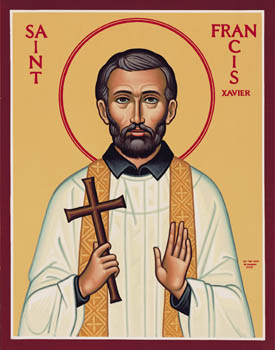 Today is the Feast Day of St. Francis Xavier, a Jesuit priest and missionary in the 1500s. His story first caught my attention when I was reading a book about the Incorruptibles; he is one of several hundred saints whose bodies have been preserved incorruptible after death. His story, from ordination to death, is quite remarkable.
Today is the Feast Day of St. Francis Xavier, a Jesuit priest and missionary in the 1500s. His story first caught my attention when I was reading a book about the Incorruptibles; he is one of several hundred saints whose bodies have been preserved incorruptible after death. His story, from ordination to death, is quite remarkable.
St. Francis Xavier’s life
Francis was born in 1506 in Navarre. In 1525, after finishing some studies, he went to Paris, where he met St. Ignatius Loyola in 1529. In 1534, Francis, Loyola and five others formed the Society of Jesus (Jesuits). Francis then completed his studies in Paris and served as a teacher there for a few years before traveling to Venice to rejoin Ignatius. Both were ordained there in 1537.
In 1539, the Jesuits were in Rome preparing for their work even while they waited for approval of their order. Francis Xavier was appointed to evangelize the people of the East Indies. He arrived there, after a year-long, dangerous voyage, in 1542. He preached, ministered to the sick in hospitals, and catechized the children despite enduring persecutions from local kings and bad examples from his fellow countrymen in India.
Three years later, he moved on to Malacca, New Guinea and other islands (possibly including the Philippines), preaching and teaching. In 1547, he returned to Goa along with a Japanese named Anger or Pablo de Santa Fe. Xavier wanted to go to Japan to evangelize there, but spent two more years in India and Goa before embarking for Japan with Pablo and two other priests. He spent two years there before returning to Goa, like St. Paul, to deal with domestic troubles that had arisen among the church there during his absence.
Francis Xavier truly had a missionary heart, for despite all the places he had already reached for Jesus, he was now drawn to China. He’d heard about this country during his time in Japan and, despite Portuguese opposition to the trip, he arrived at a small island near China in 1552. There, however, the great missionary fell ill and breathed his last.
His followers, knowing they would later be moving his body to another burial place, packed it with lime to hasten its decay (moving just the bones would be easier). Ten weeks later, they returned and found the casket and body hadn’t even started decaying yet. They took the casket (with the lime) to Malacca, where they squished the saint’s body into a grave that was too short.
Five months later, they moved him to Goa, where skeptics suggested the body had been embalmed. The chief medical authority there examined the body and declared “the limbs and other parts of the body were entire and clothed in their flesh in such a way that, according to the laws of medicine, they could not possibly have been preserved by any natural or artificial means, seeing that Father Francis had been dead and buried for about a year and a half” (Cruz).
St. Francis Xavier’s legacy
One hundred fourty-two years after St. Francis Xavier died, others examined his body again and found “the body has all the appearance of being that of a living man.” His body is still enshrined in Goa, in a church built by the Jesuits, except for his right arm, which was removed in 1614 and conveyed to Rome, where it rests in a Jesuit church.
“It is truly a matter of wonder that one man in the short space of ten years (May 1542 – December 1552) could have visited so many countries, traversed so many seas, preached the Gospel to so many nations, and converted so many infidels. The incomparable apostolic zeal which animated him, and the stupendous miracles which God wrought through him, explain this marvel, which has no equal elsewhere.” ~ Catholic Encyclopedia
Today, many churches, schools and universities have been named after Saint Francis Xavier. He is the patron of all foreign missions and Navarre. He is also known as the Apostle of the Indies and the Apostle of Japan, and is considered the greatest missionary since Saint Paul.
Other saints of interest:

No Responses Yet